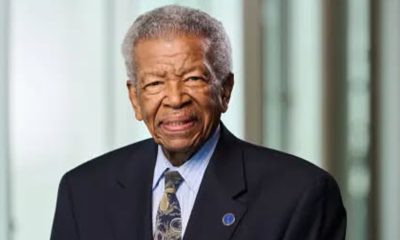#NNPA BlackPress
Educators Nationwide Pledge to Teach Truth in Schools
On the #TeachTruth National Day of Action, teachers, parents, and students said they won’t back down from the fight against anti-history bills. by Aziah Siid for Word in Black As efforts to suppress and eliminate the teaching about America’s history of racism and oppression ramp up, it’s easy to forget that a group of stalwart advocates has been […]
The post Educators Nationwide Pledge to Teach Truth in Schools first appeared on BlackPressUSA.


On the #TeachTruth National Day of Action, teachers, parents, and students said they won’t back down from the fight against anti-history bills.
by
As efforts to suppress and eliminate the teaching about America’s history of racism and oppression ramp up, it’s easy to forget that a group of stalwart advocates has been on the frontline of this fight for decades, lobbying for an accurate and comprehensive student curriculum: teachers.
For the last two summers, educators have rallied together — along with students, parents, and community members — to speak out against the anti-CRT movement. They kept the same energy this year as they pledged to #TeachTruth and defend LGBTQ+ rights.
On Saturday, June 10, 2023, people came together at roughly 100 locations nationwide for the #TeachTruth National Day of Action.
From Ruben F. Salazar Park in Los Angeles and abolitionist bookstore 1977 Books in Montgomery, Alabama, to the Stonewall Inn in New York City and the African American Civil War Memorial in Washington, D.C, attendees rallied against the anti-history education bills proliferating across the United States.
Together, they pledged to “refuse to lie to young people about U.S. history and current events.”
The Zinn Education Project, the African American Policy Forum, and Black Lives Matter at Schools coordinated the day of action, which had more than 50 co-sponsors, including the SNCC Legacy Project.
As SNCC veteran Judy Richardson told the crowd at the Washington D.C. event, “White supremacists say they want to protect their children from feeling bad about racism. What about the pain Black children have felt for decades as we were consistently fed lies and distortions about this country’s history?”
Michele Coles, author of the award-winning novel “Black Was the Ink” knows what Richardson is talking about. Coles wrote the coming-of-age novel about the Reconstruction Era due to her not learning much about that period of history in school. After one complaint from a parent, the book, told through the eyes of a Black teenage boy, was recently pulled from classrooms.
“I support the campaign to teach truth and the freedom to learn. Any society that begins banning books is headed in the wrong direction,” Coles said. “We can’t be afraid of knowledge or empathy.”
Educator, author, and Teach Truth organizer Jesse Hagopian also laid out what’s at stake.
“Lawmakers in at least 44 states have introduced legislation or pursued other measures that attempt to require educators to lie to students about the role of racism, sexism, heterosexism, transphobia, and other forms of oppression throughout U.S. history,” Hagopian wrote on Instagram. “These laws and restrictions have been imposed in at least 18 states. The Right has declared war on teaching the truth about structural racism and sexism and on LGBTQ+ youth.”
Richardson explained at the event in D.C. that supporters of these bills are afraid “that if young people — children of color and white children — see themselves in this history — in Ruby Doris Smith Robinson and Julian Bond and Anne Braden and Betty Garman Robinson and Maria Varela — then they’ll know that they can change things, too — just like the youth leaders of the Civil Rights Movement.”
New Jersey educator Thuraya Zeidan said that on Teach Truth Day, she’s championing the need to teach students from a global perspective rather than the Eurocentric lens.
“The reason that I’m here is because it’s foundational to my education philosophy that students are able to learn about themselves. We should be teaching students from a lens that is global as opposed to a lens that is Eurocentric,” she told Ande Richards, managing producer for Diversity Voices.
Organizations and bookstores like Bookworks ABQ in New Mexico that work to give access to banned or challenged books also showed up for the day of solidarity. With a table set up in the shop — and a colorful sign to jot down the name of your favorite banned book — supporters came through to take a pic with a banned book and sign the Teach Truth Pledge, while educators were offered 10% off.
Ahead of the official Teach Truth Day, national speakers, educators, and other supporters also gathered on a call before the event to share their commitments against the war on teaching the truth about structural racism, sexism, and on LGBTQ+ youth.
“We are disgusted, and we are outraged, but we’re not just angry because we can’t just be angry,” Becky Pringle, president of the National Education Association, said on the conference call. “We are organizing, and we are united. We are channeling our anger into multilayered comprehensive actions to beat back these oppressive and offensive laws — dangerous laws.”
Indeed, educators, community members, and parents are making it clear they will not back down from the fight to teach all students the full scope of what it means to be a student in America.
Whether it’s speaking out against the “Stop Woke” laws that seek to prohibit teaching about how systematic racism impacts every system in the United States or opposing the “Don’t Say Gay” bills that have students afraid to be themselves — and educators frightened to support them — supporters of the Teach Truth movement are ready to take action.
As Hagopian said, “Our movement is creating a new vision for education where history is a human right!”
The post Educators Nationwide Pledge to Teach Truth in Schools appeared first on Atlanta Daily World.
The post Educators Nationwide Pledge to Teach Truth in Schools first appeared on BlackPressUSA.
#NNPA BlackPress
LIHEAP Funds Released After Weeks of Delay as States and the District Rush to Protect Households from the Cold
BLACKPRESSUSA NEWSWIRE — The federal government has released $3.6 billion in home heating assistance after a delay that left states preparing for the start of winter without the program’s annual funding.

By Stacy M. Brown
Black Press USA Senior National Correspondent
The federal government has released $3.6 billion in home heating assistance after a delay that left states preparing for the start of winter without the program’s annual funding. The Low-Income Home Energy Assistance Program, known as LIHEAP, helps eligible households pay heating and cooling bills. The release follows a shutdown that stretched 43 days and pushed agencies across the country to warn families of possible disruptions.
State officials in Minnesota, Kansas, New York, and Pennsylvania had already issued alerts that the delay could slow the processing of applications or force families to wait until December for help. In Pennsylvania, more than 300,000 households depend on the program each year. Minnesota officials noted that older adults, young children, and people with disabilities face the highest risk as temperatures fall.
The delay also raised concerns among advocates who track household debt tied to rising utility costs. National Energy Assistance Directors Association Executive Director Mark Wolfe said the funds were “essential and long overdue” and added that high arrearages and increased energy prices have strained families seeking help.
Some states faced additional pressure when other services were affected by the shutdown. According to data reviewed by national energy advocates, roughly 68 percent of LIHEAP households also receive nutrition assistance, and the freeze in multiple programs increased the financial burden on low-income residents. Wolfe said families were placed in “an even more precarious situation than usual” as the shutdown stretched into November.
In Maryland, lawmakers urged the Trump administration to release funds after the state recorded its first cold-related death of the season. The Maryland Department of Health reported that a man in his 30s was found outdoors in Frederick County when temperatures dropped. Last winter, the state documented 75 cold-related deaths, the highest number in five years. Rep Kweisi Mfume joined more than 100 House members calling for immediate federal action and said LIHEAP “is not a luxury” for the 100,000 Maryland households that rely on it. He added that seniors and veterans would be placed at risk if the program remained stalled.
Maryland Gov. Wes Moore used $10.1 million in state funds to keep benefits moving, but noted that states cannot routinely replace federal dollars. His administration said families that rely on medical equipment requiring electricity are particularly vulnerable.
The District of Columbia has already mapped out its FY26 LIHEAP structure in documents filed with the federal government. The District’s plan shows that heating assistance, cooling assistance, weatherization, and year-round crisis assistance operate from October 1 through September 30. The District allocates 50 percent of its LIHEAP funds to heating assistance, 10 percent to cooling, 13 percent to year-round crisis assistance, 15 percent to weatherization, and 10 percent to administrative costs. Two percent is used for services that help residents reduce energy needs, including education on reading utility bills and identifying energy waste.
The District’s plan lists a minimum LIHEAP benefit of $200 and a maximum of $1,800 for both heating and cooling assistance. Crisis benefits are provided separately and may reach up to $500 when needed to resolve an emergency. The plan states that a household is considered in crisis if it has been disconnected from energy service, if heating oil is at 5 percent or less of capacity, or if the household has at least $200 owed after the regular benefit is applied.
The District’s filing notes that LIHEAP staff conduct outreach through community meetings, senior housing sites, Advisory Neighborhood Commissions, social media, posters, and mass mailings. The plan confirms that LIHEAP applicants can apply in person, by mail, by email, or through a mobile-friendly online application and that physically disabled residents may request in-home visits.
As agencies nationwide begin distributing the newly released funds, states continue working through large volumes of applications. Wolfe said LIHEAP administrators “have been notified that the award letters have gone out and the states can begin to draw down the funds.”
#NNPA BlackPress
Seven Steps to Help Your Child Build Meaningful Connections
BLACKPRESSUSA NEWSWIRE — Swinging side by side with a friend on the playground. Sharing chalk over bright, colorful sidewalk drawings. Hiding behind a tree during a spirited game of hide-and-seek. These simple moments between children may seem small, but they matter more than we think

By Niyoka McCoy, Ed.D., Chief Learning Officer, Stride/K12
Swinging side by side with a friend on the playground. Sharing chalk over bright, colorful sidewalk drawings. Hiding behind a tree during a spirited game of hide-and-seek. These simple moments between children may seem small, but they matter more than we think: They lay the foundation for some of life’s most important skills.
Through everyday play, young children begin learning essential social and emotional skills like sharing, resolving conflicts, showing empathy, and managing their emotions. These social skills help shape emotional growth and set kids up for long-term success. Socialization in early childhood isn’t just a “nice-to-have”—it’s essential for development.
Yet today, many young children who haven’t yet started school aren’t getting enough consistent, meaningful interaction with peers. Research shows that there’s a decline in active free play and peer socialization when compared to previous generations.
There are many reasons for this. Children who are home with a parent during the day may spend most of their time with adults, limiting opportunities for peer play. Those in daycare or preschool may have restricted free play, and large classrooms can reduce supervision and social coaching. Some children live in rural areas, are homebound due to illness, have full schedules, or rely on screens to fill their playtime. And for some families, finding other families with young children to connect with isn’t easy.
While these challenges can feel significant, opportunities for connection still exist in every community. Families can take simple steps to help children build friendships, create a sense of belonging, and strengthen social skills. Here are some ideas to get started:
- Storytime sessions at libraries or local bookstores
- Community offerings such as parent-child workshops, art, music, gymnastics, swimming, or sports programs
- Weekly events at children’s museums, which may include art projects, music workshops, or science experiments
- Outdoor exploration, where kids can play with peers
- Local parenting groups that organize playdates and group activities
- Volunteer opportunities where children can participate, such as pet adoption events or packing meals at a food bank
- Classes for kids at local businesses, including hardware, grocery, or craft stores
Some of these community activities are free or low-cost and give kids the chance to build friendships and practice social skills. Parents can also model positive social behavior by interacting with other parents and encouraging their children to play with their peers.
These may seem like small moments of connection, but they can have a powerful impact. Every time your child shares a toy, plays make-believe with peers, or races a friend down the slide, they’re not just playing—they’re learning the skills that build confidence, empathy, and lasting friendships. And it’s good for you, too. Creating intentional opportunities for play also helps you strengthen your own network of parents who can support one another as your children grow together.
#NNPA BlackPress
Seven Steps to Help Your Child Build Meaningful Connections
BLACKPRESSUSA NEWSWIRE — Swinging side by side with a friend on the playground. Sharing chalk over bright, colorful sidewalk drawings. Hiding behind a tree during a spirited game of hide-and-seek. These simple moments between children may seem small, but they matter more than we think

By Niyoka McCoy, Ed.D., Chief Learning Officer, Stride/K12
Swinging side by side with a friend on the playground. Sharing chalk over bright, colorful sidewalk drawings. Hiding behind a tree during a spirited game of hide-and-seek. These simple moments between children may seem small, but they matter more than we think: They lay the foundation for some of life’s most important skills.
Through everyday play, young children begin learning essential social and emotional skills like sharing, resolving conflicts, showing empathy, and managing their emotions. These social skills help shape emotional growth and set kids up for long-term success. Socialization in early childhood isn’t just a “nice-to-have”—it’s essential for development.
Yet today, many young children who haven’t yet started school aren’t getting enough consistent, meaningful interaction with peers. Research shows that there’s a decline in active free play and peer socialization when compared to previous generations.
There are many reasons for this. Children who are home with a parent during the day may spend most of their time with adults, limiting opportunities for peer play. Those in daycare or preschool may have restricted free play, and large classrooms can reduce supervision and social coaching. Some children live in rural areas, are homebound due to illness, have full schedules, or rely on screens to fill their playtime. And for some families, finding other families with young children to connect with isn’t easy.
While these challenges can feel significant, opportunities for connection still exist in every community. Families can take simple steps to help children build friendships, create a sense of belonging, and strengthen social skills. Here are some ideas to get started:
- Storytime sessions at libraries or local bookstores
- Community offerings such as parent-child workshops, art, music, gymnastics, swimming, or sports programs
- Weekly events at children’s museums, which may include art projects, music workshops, or science experiments
- Outdoor exploration, where kids can play with peers
- Local parenting groups that organize playdates and group activities
- Volunteer opportunities where children can participate, such as pet adoption events or packing meals at a food bank
- Classes for kids at local businesses, including hardware, grocery, or craft stores
Some of these community activities are free or low-cost and give kids the chance to build friendships and practice social skills. Parents can also model positive social behavior by interacting with other parents and encouraging their children to play with their peers.
These may seem like small moments of connection, but they can have a powerful impact. Every time your child shares a toy, plays make-believe with peers, or races a friend down the slide, they’re not just playing—they’re learning the skills that build confidence, empathy, and lasting friendships. And it’s good for you, too. Creating intentional opportunities for play also helps you strengthen your own network of parents who can support one another as your children grow together.
-

 Activism3 weeks ago
Activism3 weeks agoOakland Post: Week of November 12 – 18, 2025
-

 Activism3 weeks ago
Activism3 weeks agoIN MEMORIAM: William ‘Bill’ Patterson, 94
-

 Activism3 weeks ago
Activism3 weeks agoHow Charles R. Drew University Navigated More Than $20 Million in Fed Cuts – Still Prioritizing Students and Community Health
-

 Bay Area3 weeks ago
Bay Area3 weeks agoNo Justice in the Justice System
-

 #NNPA BlackPress3 weeks ago
#NNPA BlackPress3 weeks agoLewis Hamilton set to start LAST in Saturday Night’s Las Vegas Grand Prix
-

 #NNPA BlackPress2 weeks ago
#NNPA BlackPress2 weeks agoBeyoncé and Jay-Z make rare public appearance with Lewis Hamilton at Las Vegas Grand Prix
-

 #NNPA BlackPress3 weeks ago
#NNPA BlackPress3 weeks agoThe Perfumed Hand of Hypocrisy: Trump Hosted Former Terror Suspect While America Condemns a Muslim Mayor
-

 Activism2 weeks ago
Activism2 weeks agoOakland Post: Week of November 19 – 25, 2025
























































